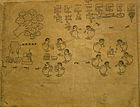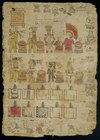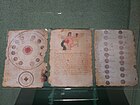Colección de Códices Originales Mexicanos
| Colección de Códices Originales Mexicanos | |
|---|---|
|
World document heritage |
|

|
|
| Tlatelolco Codex |
|
| State (s): |
|
| Duration: | 93 originals, 68 facsimiles |
| Period: | 16th Century |
| Storage: | National Museum of Anthropology , Mexico City . |
| Register link: | Collection of Mexican Codices |
| Admission: | 1997 ( session 3 ) |
The Colección de Códices Originales Mexicanos ("Collection of Original Mexican Codices") is a codex collection of the Biblioteca Nacional de Antropología e Historia in the National Museum of Anthropology in Mexico City . It comprises a codex from the pre-colonial period ( Codex Colombino ), 92 original codices and codex fragments from the colonial period and 68 historical facsimiles . Most of these illuminated manuscripts were created in the 16th century. In 1997 the collection was included in the UNESCO World Document Heritage .
History of the collection
The foundation of the holdings, which is now in the Biblioteca Nacional de Antropología e Historia, is the collection that Lorenzo Boturini brought together between 1736 and 1743. He was able to integrate earlier book holdings by Alva Ixtlilxochtli and Sigüenza y Góngora into his collection.
Since the end of the 19th century, Boturini's collection, which was in the Museo Nacional de Arqueología, Historia y Etnografía, was enlarged by further acquisitions. The most important acquisition was the Colombino Codex (1891), the only original of a pre-Spanish Codex in Mexico. The most recent significant donation is the Codex de la Cruz-Badiano .
Content
Not all codices have a clear main topic. The Dehesa Codex is a compendium of historical, genealogical, religious-ritual and calendar texts.
The oldest codex, the Colombino Codex from pre-Hispanic times, contains genealogical information about aristocratic dynasties. In the colonial era, too, genealogical texts were created in order to enforce inheritance claims in legal disputes. Another group of texts are of a ritual-calendar nature. Maps and plans can also provide historical and genealogical information. Tax lists contain information about economic life before and during the colonial era. Jacobo de Testera is considered to be the author of several Christian books in which traditional imagery was used for catechesis . The botanical-medical Codex de la Cruz-Badiano was written at the instigation of the colonial rulers who were interested in the relevant knowledge of the indigenous population.
Codices preserved in the original
The following list adopts the information on the individual codices from the information on nomination for UNESCO World Heritage Sites:
| image | Surname | Time of origin | description |
|---|---|---|---|

|
Huamantla Codex | 16th Century | 6 fragments |
| Plan of part of Mexico City | 16th Century | 238 × 168 cm | |
| Baranda Codex | 17th century | 37 × 228 cm | |
| La Cueva Codex | 16th Century | 77.5 × 160 cm | |
| Annals of Tula | 16th Century | 17 × 487 cm | |
| Code of expenditure | 16th Century | 104 × 32 cm | |

|
Plan of Sigüenza | 16th Century | 54.5 × 77.5 cm |
| Coatlinchan plan | 16th Century | 44.5 × 41.5 cm | |
| Cuetlaxcohuapan Codex | around 1530 | 50.7 × 35.8 cm | |
| Sevina cloth | 16th Century | 125 x 97.5 cm | |
| Coateptl's plan | 16th Century | 56 × 42 cm | |
| Mauricio de la Arena Codex | 16th Century | 6 fragments | |
| Chavero Codex | around 1579 | 6 fragments | |
| Moctezuma Codex | 16th Century | 250 × 20 cm | |
| Genealogy of a family from Tepeticpac | 16th Century | 119.5 x 58.8 cm | |
| Quiotepec and Cuicatlán Codex | 16th Century | 61 × 102 cm | |

|
Colombino Codex | Originated before the Spanish conquest | 24 pages, 18.5 × 606.5 cm |
| Plan of Cuauahtinchan | 16th Century | Several parts | |
| Contlanzinco paintings | 18th century | 74 × 53.5 cm | |
| Santo Tomás Xochtlan painting | 18th century | 67 × 41 cm | |
| Mixtec Codex from the time after Cortes | 16th Century | 85 × 87 cm | |

|
Boturini Codex | around 1540 | 9.8 × 549 cm |

|
Tlatelolco Codex | around 1565 | 40 × 325 cm |
| Nahuatzen cloth | 16th Century | 72 × 102 cm | |
| Zolin genealogy | 16th Century | 44 × 35 cm | |
| García Granados Codex | 17th century | 49.5 × 674 cm | |
| Porfirio Díaz Codex | 17th century | 21 pages, 15.5 × 421 cm | |
| Dehesa Codex | 17th century | 23 pages, 17.5 × 498 cm | |

|
Tax register | 16th Century | 16 pages, 42 × 29 cm |
| Prayer book | 16th Century | 11 pages, 15.6 × 11 cm | |
| Cholula Codex | around 1586 | 112 × 166 cm | |
| Santa Cruz Tlamapa Tax Code | 1577 | 8 sheets, 383.5 × 31 cm | |
| Tequitlato de Zapotitlán Codex | around 1561 | 25.6 × 85 cm | |
| Incomplete topographical codex | 16th Century | 102 × 112 cm | |
| Metztepetl Genealogy | 16th Century? | 88 × 68 cm | |
| Zacatepec cloth | 16th Century | 325 × 225 cm | |
| Codex of the Lords of San Lorenzo Axotlán and San Luis Huexotla | around 1672 | 29 x 111.5 cm | |
| San Antonio Techialoyan Codex | 17th century | 26 × 21 cm | |
| Tizimin book by Chilam Balam | 18th century | 21.5 x 14.6 cm | |

|
Ixil book by Chilam Balam | 18th century | 44 pages, 21.5 × 14.6 cm |
| Muro Codex | 17th century | 14.8 x 223 cm | |
| San Juan Teotihuacan Codex | around 1557 | 139 × 75 cm | |
| Tlaxcala Codex | 16th Century | 97.5 × 83 cm | |
| Tax fragment | around 1570 | 38 x 18.9 cm | |
| Xalapa Codex | 1540 | 81.5 × 45.5 cm | |
| Plan of a wooded area | 16th Century | 7.5 x 4.5 cm | |
| Plan of Otumba | 17th century | 106 × 61.5 cm | |
| Plan of Tepecuacuilco | 16th Century | 113 × 102 cm | |
| Caltecpaneca fragment | 16th Century | 18 × 55 cm | |
| Pitzahua genealogy | 16th Century | 26 × 31 cm | |
| Nopalxochitl Genealogy | 16th Century | 22 × 31 cm | |
| Genealogies of Nexmoyotla, Ateno, Zoyatitlan, and Heuytetla | 17th century | 31.5 × 86.5 cm | |
| Genealogies of Tetlamaca and Tlametzin | 16th Century | 111 × 60 cm | |
| Genealogies of Cotitzin and Zozahuic | 16th Century | 32.5 × 17 cm | |
| Genealogies of the lords of Etla | 17th century | 6 sheets | |
| Teotenantzin Codex | 18th century | 44 × 117 cm | |
| Codex of Don Andrés' possessions | 16th Century | 15.7 x 86.6 cm | |
| Plan of Santa María Nativitas Tultepeque | around 1578 | 72 × 64 cm | |
| San Cristóbal Coyotepec Codex | 17th century | 74 × 96 cm | |
| Plan on Amatl paper | 16th Century | 40.5 × 34 cm | |
| Lachiyoo's plan | 18th century | 107 × 85 cm | |
| San Juan Nayotla cloth | 1590 | 194 × 236 cm | |
| Castile coat of arms | 16th Century | 41 × 34 cm | |
| Ixtapalapa Codex | 17th century | 58 × 37 cm | |
| Azoyú Codex | 16th Century | two parts | |
| Tlapa cloth | 17th century | 285 × 76 cm | |
| Chinantla cloth | 17th century? | 110 x 130 cm | |
| Coixtlahuaca cloth | 16th Century | 425 × 300 cm | |
| Cloth from Tecciztlan and Tequatepec | 16th Century | 280 × 170 cm | |
| Certificates from Tocuaro | 17th century | 12 pages | |
| Mizquiahuala Tax Code | around 1570 | 2 fragments | |
| Porrua Turanzas Codex | 16th Century | 9 fragments | |
| Yatini cloth | 18th century | 160 × 117 cm | |
| Valeriano Codex | 1574 | 22 x 31.8 cm | |
| San Lucas Yataú cloth | 17th century | 105 × 86 cm | |
| View of the Chiapa River | 18th century | 37 × 142 cm | |
| Cristo de Mexicaltzinco Codices | 17th century | 7 fragments | |
| Cuauhtli genealogy | 16th Century | 21.4 x 30.2 cm | |
| Analco cloth | 16th Century | 173 × 262 cm | |
| Plan by Cuauhtlantzinco | 17th century | 9 sheets | |
| Gómez de Orozco Codex (Catechism) | 16th Century | 6 pages | |
| San Juan Huautla painting | 17th century | 107 × 105 cm | |
| Chan Kan book by Chilam Balam | 19th century | 128 sheets | |
| Pérez Codex | around 1837 | 239 sheets | |

|
Codex de la Cruz-Badiano | 16th Century |
literature
- Mexico - Collection of Mexican Codices . Nomination Form for the Memory of the World International Register. 1997 (English, unesco.org [PDF; 73 kB ]).
Web links
- Collection of Mexican Codices on the UNESCO World Document Heritage website
Individual evidence
- ^ Memory of the World International Register Nomination Form: Mexico - Collection of Mexican Codices , p. 1.
- ^ Memory of the World International Register Nomination Form: Mexico - Collection of Mexican Codices , p. 6.
- ^ Memory of the World International Register Nomination Form: Mexico - Collection of Mexican Codices , p. 7.
- ^ Memory of the World International Register Nomination Form: Mexico - Collection of Mexican Codices , pp. 7–8.
- ^ Memory of the World International Register Nomination Form: Mexico - Collection of Mexican Codices , pp. 2-4.
Coordinates: 19 ° 25 ′ 34 ″ N , 99 ° 11 ′ 10 ″ W.
